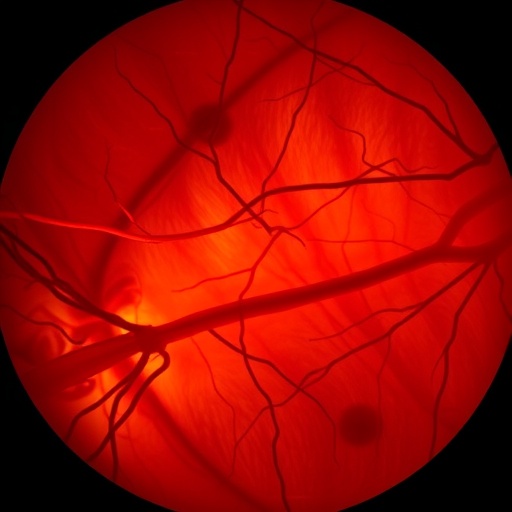In the complex and multifaceted architecture of the mammalian retina, amacrine cells occupy a critical role in modulating visual signals before they reach the brain. Unlike many neurons that possess distinct axons as output pathways, a significant number of amacrine cells release neurotransmitters directly from their dendritic processes. This unconventional mechanism blurs the traditional neuronal compartmentalization between input and output sites, compelling neuroscientists to reconsider how these cells contribute to the intricate processing of visual information. Recent groundbreaking research has thrust light on the heterogeneity of amacrine cell types by meticulously mapping their input and output fields, revealing a sophisticated landscape of spatial compartmentalization that underpins their functional diversity.
This recent investigation probed into the compartmentalization of synaptic inputs and outputs along the two principal retinal axes — the nasotemporal and dorsoventral directions. Using advanced imaging techniques, the researchers mapped the receptive fields (RFs), representing the areas where amacrine cells receive inputs, alongside projective fields (PFs), the spatial distribution of their GABAergic outputs. By aligning ROIs (regions of interest) associated with GABA release relative to receptive field centers, they defined these projective fields, effectively quantifying where on the retina these cells exert inhibitory influence. This enabled the researchers to observe the spatial relationship between where signals are received and where inhibitory signals are dispatched, unveiling patterns previously unrecognized in retinal neuroscience.
Key findings demonstrated that these receptive-projective field relationships vary substantially across distinct amacrine cell response groups. For instance, one group tagged as delayed-ON G6 exhibited projective fields nested neatly inside their receptive fields, suggesting a close spatial concordance between input and output locations. In contrast, other delayed-ON types, namely G2 and G4, showed spatial biases in their projective fields, skewed toward the temporal and ventral regions relative to their receptive fields, respectively. This offset points strongly toward dendritic segmentation within these cells, where different parts of the same neuron serve as input receivers or output emitters, enabling directional processing and spatially selective inhibition.
Further stratifying this landscape, the study illuminated that TTX-sensitive wide-field amacrine cells, notable for their polyaxonal morphologies, display even more pronounced spatial offsets between receptive and projective fields. These findings imply that sodium channel–mediated action potentials propel GABA release at sites distant from synaptic inputs along long axon-like projections. Such a mechanism offers a fascinating blueprint for how inhibitory signals may be conveyed over broader retinal territories, contributing to complex integrative functions including motion detection and contrast modulation. Collectively, these observations highlight a rich diversity in how amacrine cells spatially organize their input-output relationships, governed by their molecular identities and connectivity patterns.
Diving deeper, the research revealed that the shapes, sizes, and degrees of spatial overlap between receptive and projective fields vary substantially across cell groups. This variance cannot be oversimplified; instead, it reflects an intrinsic property of retinal architecture where specific inhibitory circuits are finely tuned to process various aspects of visual stimuli. The dynamic relationship between excitatory inputs and inhibitory outputs creates a neural tapestry that endows the retina with responsiveness to motion, direction, orientation, and other spatiotemporal features. This structural and functional compartmentalization elucidates how the retina transcends mere light detection to perform intricate preprocessing before conveying signals upstream.
Contrasting with these GABAergic inhibitory pathways, glutamatergic signals — primarily originating from bipolar cells — revealed markedly less complexity in receptive-projective field relationships. Using a fluorescent glutamate sensor targeted to ON–OFF direction-selective retinal ganglion cell dendrites, the researchers confirmed that glutamatergic pathways maintain a more direct and less spatially dispersed connectivity profile. This divergence emphasizes the pivotal role of GABAergic amacrine cells in diversifying retinal information processing and highlights neurotransmitter-specific circuit strategies within the retina. In essence, GABA neurotransmission appears to orchestrate a richer palimpsest of spatial and temporal information than its glutamatergic counterparts.
These findings accord with prior studies from model organisms such as the tiger salamander, which uncovered that bipolar cells relay signals predominantly along single vertical axes. Together, this body of evidence underscores a conserved principle in retinal processing: excitatory signals tend to follow more rigid, linear pathways, while inhibitory circuits mediated by amacrine cells enact spatially flexible, directionally nuanced modulation. Such complexity in inhibitory architecture likely underlies the retina’s sophisticated ability to parse dynamic visual scenes, emphasizing the centrality of these interneurons in shaping visual perception from the very first synaptic stages.
Beyond spatial compartmentalization, the research employed advanced quantitative metrics, such as directional and orientational bias indexes, overlap indices, and size change indices, to robustly characterize these synaptic relationships. Clustering analyses based on projective field properties revealed distinct classes of amacrine cells, categorized by their spatial tuning and functional attributes. Notably, directionally biased groups clustered apart from orientationally biased groups, each showing unique distributions of response properties. This granular classification enables a more nuanced understanding of amacrine cell heterogeneity, painting a detailed picture of how inhibitory circuitry supports diverse computational roles within the retina.
The implications of these discoveries extend beyond fundamental retinal neurobiology. The compartmentalization of synaptic inputs and outputs in amacrine cells suggests potential mechanisms by which neural circuits can independently regulate incoming excitation and outgoing inhibition within a single neuron. This dual functionality may allow for localized, synapse-specific modulation, supporting complex computations such as contrast enhancement, motion detection, and temporal filtering. Moreover, the spatial offsets between input and output sites could underpin mechanisms of lateral inhibition and surround suppression, foundational features that sharpen sensory acuity and prevent overstimulation.
Methodologically, the study harnessed state-of-the-art imaging modalities and genetically encoded sensors enabling simultaneous recording of GABAergic and glutamatergic signaling with exceptional resolution. These tools facilitated mapping of functional connectivity with unprecedented spatial precision, making it possible to visualize the direct correspondence between synaptic inputs and outputs on individual amacrine cells. This methodological advancement sets new benchmarks for dissecting microcircuits in the central nervous system, demonstrating the power of combining optical techniques with molecular specificity to unravel neural circuitry.
The insight that GABA neurotransmission in the retina is spatially and functionally multifaceted adds a new layer of complexity to our understanding of how sensory systems encode information. It challenges the long-standing simplified view of amacrine cells as homogenous inhibitory interneurons and instead elevates them as dynamic, compartmentalized processors that shape emergent visual properties. Such intricate inhibitory networks suggest that pharmacological or genetic perturbations targeting specific amacrine cell types could significantly influence visual function, offering avenues for therapeutic intervention in retinal diseases.
Finally, this study underscores a broader neuroscientific principle: the architecture of neuronal microcircuits is not merely defined by cell types but also by the fine-scale spatial relationships between their synaptic input and output domains. This principle, elegantly demonstrated in the retina, likely echoes throughout the brain, where dendritic compartmentalization and axonal projections orchestrate complex computations essential for perception, cognition, and behavior. The mammalian retina, long admired as a model system, continues to reveal secrets that resonate far beyond the visual system, informing our global understanding of neural circuit function.
In sum, the comprehensive mapping and analysis of amacrine cell input-output compartmentalization fundamentally enhances our grasp of retinal inhibitory circuits. By revealing how diverse GABAergic neurons sculpt spatiotemporal visual encoding through spatially segregated synaptic sites, this research sets a new paradigm for interpreting visual processing. It provides a conceptual and technical blueprint for exploring interneuronal diversity and circuit specialization, promising a future where the enigmatic retina elucidates principles applicable across the nervous system.
Subject of Research: Functional compartmentalization and spatial mapping of synaptic inputs and outputs in GABAergic amacrine cells within the mouse retina.
Article Title: Functionally distinct GABAergic amacrine cell types regulate spatiotemporal encoding in the mouse retina.
Article References:
Matsumoto, A., Morris, J., Looger, L.L. et al. Functionally distinct GABAergic amacrine cell types regulate spatiotemporal encoding in the mouse retina. Nat Neurosci (2025). https://doi.org/10.1038/s41593-025-01935-0
Image Credits: AI Generated
Tags: advanced imaging techniques in neurosciencefunctional diversity of amacrine cellsGABAergic amacrine cellsinhibitory influence in retinal circuitrymammalian retina architecturenasotemporal and dorsoventral retinal axesneurotransmitter release mechanismsreceptive and projective fieldsretinal signal modulationspatial organization of retinal neuronssynaptic compartmentalizationvisual information processing





